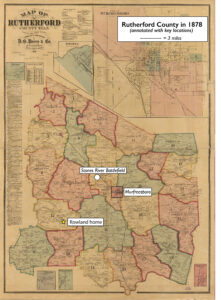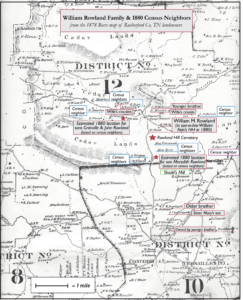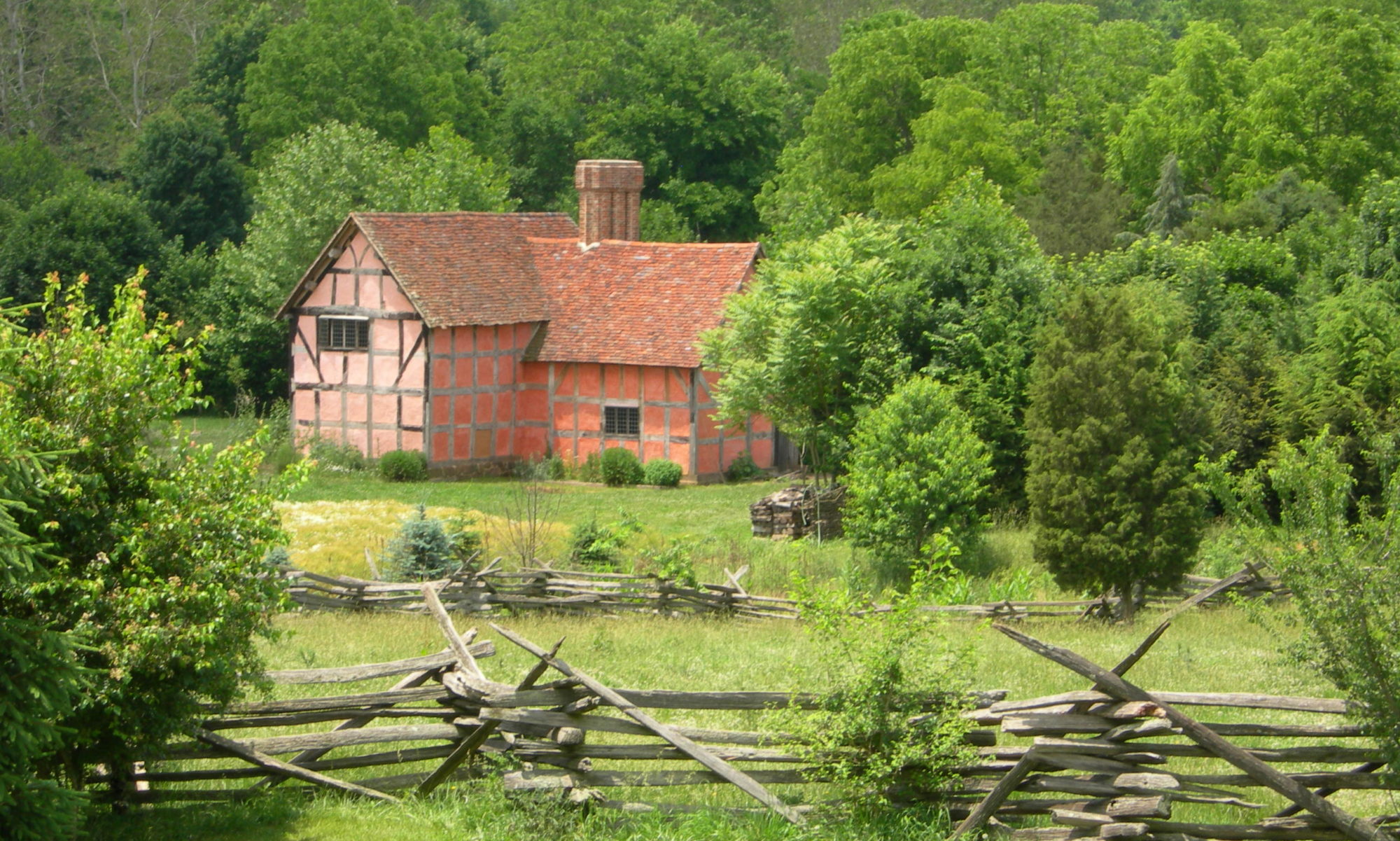John Woods Rowland was the third son and seventh child of William M. Rowland and Elizabeth C. Brown, who lived in Rutherford County their entire lives. John was born in 1859 in the rural southwest corner of the county, not far from the village of Rockvale. (1) During his long lifetime, he experienced the upheavals caused by three wars and two national financial collapses by the time he died in 1946 in the town of Harriman in eastern Tennessee’s Roane County. (2)
As a child, John experienced the hardships of the Civil War first-hand. In 1862, Union and Confederate battle lines moved across the county several times before the Union finally defeated the Confederates at the Battle of Stones River (31 December 1862-2 January 1863) and garrisoned a military force at the county seat of Murfreesboro.

In Murfreesboro, as in other garrisoned towns, Union forces established a certain level of order and gave local officials responsibility for administering civil government, though civilian courts were suspended. Residents had their homes searched and even seized, with fencing and animals taken to supply Union troops. Food shortages were common, as imports from surrounding farms dried up, and prices soared for common goods. (3)
In the rural areas of the county, termed the “no man’s land,” conditions were even worse. Union foraging squads frequently swept through, seizing whatever they could find from family farms with no recompense. As one Civil War scholar put it, “[F]ew residents of no-man’s-land went for long without a visit from soldiers who demanded cornmeal, salt pork, hogs, cattle, chickens, hay, fodder, and any other edibles.” The army also seized farm animals for its own use and wooden fencing was taken to use as firewood for the troops. (4)
Adding to the insecurity were Confederate guerrilla bands that roved the countryside, seeking revenge on Federal foragers or Union sympathizers. Stragglers and bandits from both sides robbed and harassed residents at will. With roads unsafe to travel, people stayed home, and schools and churches largely suspended their activities. A reporter travelling with Union General Rosecrans in late 1862 described it this way:
“Fallow fields were spread out before the vision… Fences had been absorbed in camp-fires; the click of the old mill wheel had ceased; broken windows and shattered frames stared from deserted homesteads… Ravage and desolation everywhere. There were no little children gamboling on cabin thresholds. Hardly a dog barked.” (4)
The Union Army was not the only source of destruction. Confederate forces returned to the area for brief periods in 1863 and late 1864, taking what they needed from the war-ravaged residents before falling back as Union troops rallied to push them out.
Living as they did, within a few miles of the Union garrison at Murfreesboro, the Rowland family would not have been spared. From 1862 to the war’s end in 1865, they and their neighbors would have known fear, isolation, and hunger to the point of famine. (5)
Once the war ended, life in rural Rutherford County began returning to normal as people felt free to resume their usual activities without fear of attack. The six-year-old John would have begun attending one of the local one-room schools in 1865 or 1866, but formal education was not held in high value on the farm where extra male hands were always needed to work the crops and tend to livestock. Even before the Civil War, school attendance was not mandatory in Tennessee; in 1860, less than half of children in the state attended school at all. (6) John’s formal education ended after third grade. (7)
By 1880, John was working as a farm hand for his older brother, Granville, not far from where their parents were living with his sister Martha Rowland Fain and her family. (8)

John apparently married for the first time in 1883, when he wed Mary J. Jenkins in Rutherford County. (9) The couple probably met through family and neighborhood connections; in the 1880 census, Mary lived with her parents, Eli and Nancy Jenkins, in the 10th Civil District, in between John’s uncle Littleberry Rowland and James W. Shedd, who operated a grist mill on the line between the 10th and 12th Civil Districts about two miles south of where John and Granville probably lived. (See above map.)
John resided in Rutherford County for the next decade, probably working as a farmer. Though he never bought land, he was listed in Rutherford County tax books as living in the 10th and then the 12th Civil Districts during this time, where he paid poll and school taxes most years. The 1891 list of male voters also identifies him as living in Civil District 12.
By 1892, Mary had died, and the widowed John married Anna Lou Whitus in February. Anna was the daughter of George Washington Whitus and Nancy Levina Puckett; born in neighboring Bedford County, the Whitus family moved to Rutherford County by 1870 and to the 12th Civil District by 1885. (10) John and Anna’s first child, Leonard, was born in Rutherford County nine months later. (11) (See separate bio for Anna.)
Within a year, however, John moved his family east to the small town of Oliver Springs, where his second child, Irwin Washington, was born in 1895. The town sits astride the junction of Roane, Anderson, and Morgan Counties, and in 1900 had only 700 inhabitants. It’s unclear what drew them to the area; they had, at that time, no known relatives or associates there although Anna’s parents followed soon after. However, industries such as coal mining, lumber mills, and iron and steel furnaces were expanding significantly at that time, including in the Cumberland Plateau, where Roane County is located. It is possible that John was attracted by the potential for work in the area. (12)
In 1900, the family was enumerated in Oliver Springs, where John worked as a teamster. (13) In all, six more children were born to John and Anna, nearly all in or around Oliver Springs. Only his son John was born elsewhere, in Rhea County in 1909; we don’t know what drew them to that area but they didn’t remain long and were back in southeastern Morgan County, not far from Oliver Springs, by the 1910 census, when John and his two eldest sons were working as coal miners. (14)
By 1913, John and his family had moved to the small town of Harriman, in north-central Roane County, where he and Anna would remain until 1946. (15) Like many others in Harriman, John and most of his children worked at the Harriman Hosiery Mill on Siluria Street, six blocks from their rented home. (16) The family almost certainly was affected during a failed year-long strike by mill workers from 1933 to 1934. (17)
John and Anna made room in their home for their children and grandchildren who were also going through hard times. In 1930, their widowed son Irwin’s two children were living with their grandparents. And in 1940, their unemployed daughter Florence and her two children were living with them while she was apparently separated from her second husband.
It’s unclear what John’s source of income was in 1940. According to the census, he was not working due to old age, but did have some source of outside income though it wasn’t specified in the census. His married daughter Katie Rowland Posey lived next door with her husband, and both were employed; it’s possible she was helping support her parents.
John died in 1946 from arteriosclerosis and myocarditis. He is buried in Willard Park Cemetery south of the town.
© 2021, Donna Rowland Gough, all rights reserved.
Sources:
- Tennessee Department of Public Health, death certificate, no. #21891 (1946), John W. Rowland, Division of Vital Statistics, Nashville.
- Tennessee Department of Public Health, delayed birth certificate, no. #D-148936 (1942), Harry Rowland, Division of Vital Statistics, Nashville; World War II Draft Cards, 1940-1947, digital images, Ancestry.com, accessed 14 Aug 2021, John Wesley Rowland, serial # 2875, order #111, Roane County, Tennessee.
- Stephen V. Ash, Middle Tennessee Society Transformed, 1860–1870: War and Peace in the Upper South; Baton Rouge: Louisiana State University Press, 1988, pp 90-92.
- Stephen V. Ash, When the Yankees Came: Conflict & Chaos in the Occupied South, 1861-1865, Chapel Hill: University of North Carolina Press, 1995, pp 99-106.
- Ibid.
- Paul H. Bergeron, Stephen V. Ash, Jeanette Keith, Tennesseans and Their History; Knoxville: University of Tennessee Press, 1999, p. 193
- Stephen V. Ash, Middle Tennessee Society Transformed, 1860–1870, pp 178-179; 1940 US census, Roane County, Tennessee, Harriman City, population schedule, enumeration district (ED) 2, sheet 11-B, dwelling #252, J.W. Rowland, accessed via Ancestry online 20 Aug 2021; 1870 U.S. census, Rutherford County, Murfreesboro P.O., Tennessee, population schedule, sheets 424-425 (stamped), dwelling #149, family #150, Wm. Rowland, accessed via Ancestry.com 14 Apr 2018.
- 1880 U.S. census, Rutherford County, Tennessee, population schedule, enumeration district (ED) 198, page 13, dwelling #104, family #105, Gran. Rowland, accessed via Ancestry.com 27 Jan 2008; 1880 U.S. census, Rutherford County, Tennessee, enumeration district (ED) 198, p. 17, dwelling #143, family #144, William G. Fain, accessed via Ancestry.com 17 May 2014.
- Rutherford County, Tennessee, Marriage Records, Book 1 (1881-1889), p 65, J.W. Rowland and Miss M.J. Jenkins, 1883, accessed via FamilySearch, FHL #379650; while the entry lists him only as J.W. Rowland, there is no other male Rowland of those initials in the county at that time.
- Deposition of claimant, 22 Oct 1906, Nancy Puckett Whitus, widow’s indigent pension application, service of George Washington Whitus, Tennessee State Archives; Tennessee Department of Public Health, death certificate, file #51-18537, Annie Lou Rowland, Division of Vital Records, Nashville.
- Rutherford County, Tennessee, Marriage Records, Book 2 (1889-1907), p 89, J.W. Rowland and Miss Annie Lou Whitis entry, 1892, accessed via FamilySearch, FHL #379650; Tennessee Department of Public Health, delayed birth records, 1869-1909 (1953), file #D-427079, Leonard Elgin Rowland.
- Bergeron, Ash, & Keith, Tennesseans and Their History, pp 186-187.
- 1900 U.S. census, Roane County Tennessee, population schedule, enumeration district (ED) 116, sheet 2-B, dwelling #36, family #37, John W. Roland, accessed via Ancestry.com 27 Jan 2008.
- 1910 U.S. census, Morgan County Tennessee, population schedule, enumeration district (ED) 51, sheet 16-B, dwelling #437, family #439, John Rowland, accessed via Ancestry.com 27 Jan 2008; Margaret Epperson, granddaughter of Leonard Rowland, to Donna Rowland Gough, e-mail, 27 Mar 2008.
- Tennessee Department of Public Health, delayed birth certificate, file #D-567474, 1913, Florence Eva Rowland, Bureau of Vital Statistics, Nashville, TN.
- World War II Draft Cards, 1940-1947, digital images, Ancestry.com, accessed 14 Aug 2021, John Wesley Rowland, serial # 2875, order #111, Roane County, Tennessee.
- Patrick D. Reagan, “Harriman Hosiery Mills Strike of 1933-34,” Tennessee Encyclopedia, https://tennesseeencyclopedia.net/entries/harriman-hosiery-mills-strike-of-1933-34/, 8 Oct 2017, accessed 14 Aug 2021.
